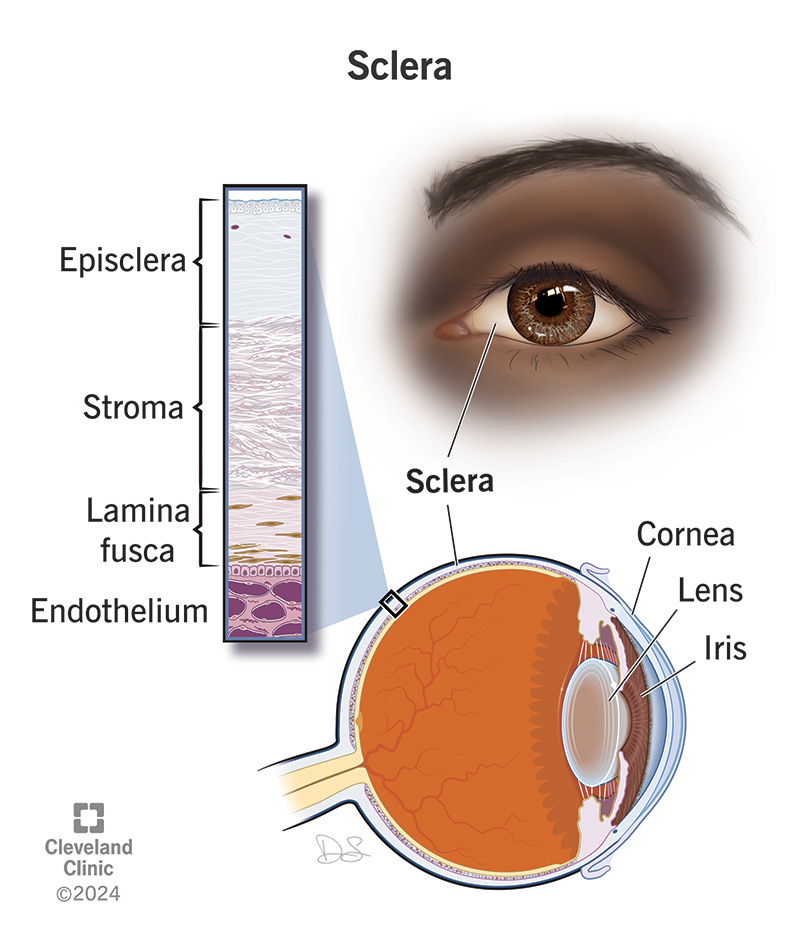The sclera, or white of the eye, is strong tissue that wraps around your eyeball. It helps maintain your eye’s shape and protects it from injury. Many irritants or health conditions can make the entire sclera change color or cause spots of color. Visit a healthcare provider or eye care specialist if you notice changes in your eyes or vision.
Advertisement
Cleveland Clinic is a non-profit academic medical center. Advertising on our site helps support our mission. We do not endorse non-Cleveland Clinic products or services. Policy

The sclera is the white part of your eye. It’s a protective covering that wraps over most of your eyeball. It extends from the cornea at the front of your eye to the optic nerve in the back.
Advertisement
Cleveland Clinic is a non-profit academic medical center. Advertising on our site helps support our mission. We do not endorse non-Cleveland Clinic products or services. Policy
The sclera is thin — only around a millimeter thick (the same as a credit card) — but it’s a strong, protective layer of tissue that gives your eye its white color. It protects and supports your eye. The plural for sclera is sclerae.
The sclera is the supporting wall for your eyeball. It maintains your eye’s shape and protects it from injuries.
Muscles attached to the sclera help you move your eyeball.
The sclera is made of tough collagen fibers. Collagen is a protein that’s the main ingredient in your body’s skin, muscles, bones and connective tissues.
The collagen fibers in your sclera crisscross each other in a random pattern that makes the sclera strong and flexible. That web of collagen fibers is what makes the sclera white.
The random pattern of collagen fibers layered on top of each other makes your sclera white. They’re stacked crisscrossing over each other so they don’t let as much light through as other parts of your eye. For example, collagen fibers in your cornea (the clear part at the front of your eye) are neatly organized, which makes them clear enough for you to see through.
The sclera has four layers sandwiched on top of each other and connected to other parts of your eye:
Advertisement
Lots of issues and conditions can change the whites of your eyes to other colors. Everyone’s eyes are occasionally red or irritated, but you should visit an eye care specialist or healthcare provider if you notice any changes in your eyes or sclerae that last for more than a day or two.
Some eye conditions that can affect your sclera’s color include:
Eye injuries and everyday eye irritation (like dust, allergies, smoke or sun exposure) can cause red eye (bloodshot eyes).
Visit a healthcare provider or eye care specialist if you notice changes in your eyes, including color changes or eye pain.
An eye care specialist will perform an eye exam to diagnose what’s causing the discolored sclera. They’ll suggest treatments to manage the cause, which should help the whites of your eyes return to their usual color.
You might need:
Ask your eye care specialist how to manage any underlying health conditions you have and which treatments they recommend.
The best ways to protect your sclera (and the rest of your eye) include:
Visit an eye care specialist if you notice any changes in your eyes or vision, including:
Most people see their sclerae every time they look in the mirror but never notice them unless they’re red, irritated or painful. Occasional irritation or discoloration in the whites of your eyes is common, but don’t ignore changes in your vision, eye pain or other symptoms. It’s never a bad idea to visit an eye care specialist if you’re worried about your eyes. They’ll help you understand what’s causing any symptoms you’re experiencing.
Advertisement
Getting an annual eye exam at Cleveland Clinic can help you catch vision problems early and keep your eyes healthy for years to come.

Last reviewed on 02/07/2024.
Learn more about the Health Library and our editorial process.